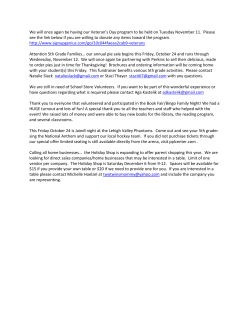
Regular Languages
Theory of Computation
Chapitre 3 : Regular Languages
Instructor : Mohamed Amin Hadj taieb
Web site : https://uqu.edu.sa/staff/ar/4350501
Email : mmtayyeb@uqu.edu.sa
medamin.hadjtaieb@gmail.com
1
Outline
• Regular expressions
• Regular languages
• Equivalence between languages accepted by
FA and regular languages
• Closure Properties
medamin.hadjtaieb@gmail.com
2
Definitions
• A language is a set of strings
• String: A sequence of letters
–
Examples: “cat”, “dog”, “house”, …
–
Defined over an alphabet:
a, b, c,, z
3
Alphabets and Strings
• We will use small alphabets:
• Strings
a
ab
abba
baba
aaabbbaabab
a, b
u ab
v bbbaaa
w abba
4
Regular Expressions
• In computer science, RE is a language used for specifying text
search string.
• A regular expression is a formula in a special language that is
used for specifying a simple class of string.
• Formally, a regular expression is an algebraic notation for
characterizing a set of strings.
• RE search requires
– a pattern that we want to search for, and
– a corpus of texts to search through.
Basic Regular Expression Patterns
•
The use of the brackets [] to specify a disjunction of characters.
•
The use of the brackets [] plus the dash - to specify a range.
6
Basic Regular Expression Patterns
•
Uses of the caret ^ for negation or just to mean ^
•
The question-mark ? marks optionality of the previous expression.
•
The use of period . to specify any character
7
Finite State Automata
• FSAs recognize the regular languages represented by
regular expressions
– SheepTalk: /baa+!/
b
q0
a
q1
a
q2
a
!
q3
q4
• Directed graph with labeled nodes and arc transitions
•Five states: q0 the start state, q4 the final state, 5
transitions
8
Formally
• FSA is a
5-tuple consisting of
– Q: set of states {q0,q1,q2,q3,q4}
– : an alphabet of symbols {a,b,!}
– q0: A start state
– F: a set of final states in Q {q4}
– (q,i): a transition function mapping Q x to Q
a
b
q0
a
q1
a
q2
!
q3
q4
9
• FSA recognizes (accepts) strings of a regular
language
– baa!
– baaa!
– baaaa!
–…
b
q0
a
q1
a
q2
a
q3
!
q4
• Tape Input: a rejected input
a
b
a
!
b
10
State Transition Table for SheepTalk
Input
State
baa!
baaa!
baaaa!
baaaaa
!
...
a
b
q0
a
q1
a
q2
!
q3
q4
b
a
!
0
1
Ø
Ø
1
Ø
2
Ø
2
Ø
3
Ø
3
Ø
3
4
4
Ø
Ø
Ø
11
Non-Deterministic FSAs for SheepTalk
b
q0
a
q1
b
q0
a
q2
a
q1
a
!
q3
a
q2
q4
!
q3
q4
12
Regular Expressions
Regular expression over alphabet
• is a regular expression.
• is a regular expression.
• For any a, a is a regular expression.
• If r1 and r2 are regular expressions, then
– (r1 + r2) is a regular expression.
– (r1 r2) is a regular expression.
– (r1* ) is a regular expression.
• Nothing else is a regular expression.
medamin.hadjtaieb@gmail.com
13
RegularLanguages
• is a regular language corresponding to the regular
expression .
• {} is a regular language corresponding to the regular
expression .
• For any symbol a, {a} is a regular language
corresponding to the regular expression a.
• If L1 and L2 are regular languages corresponding to
the regular expression r1 and r2, then
– L1L2, L1L2, and L1* are regular languages
corresponding to (r1 + r2) , (r1 r2), and (r1*).
medamin.hadjtaieb@gmail.com
14
More complex examples
Let = {0,1}.
• {*| contains odd number of 1’s}
– 0*(10*10*)*10*
• {*| any two 0’s in are separated by three
1’s}
– 1*(0111)*01* + 1*
• {*| is a binary number divisible by 4}
– (0+1)*00
• {*| does not contain 11}
– 0*(10+)* (1+) or (0+10)* (1+)
medamin.hadjtaieb@gmail.com
15
Notation
Let r be a regular expression.
The regular language corresponding to
the regular expression r is denoted
by L(r).
medamin.hadjtaieb@gmail.com
16
Some rules for language
operations
Let r, s and t be languages over {0,1}
r+=+r=r
r+s=s+r
r = r
=r
r = r =
r(s + t) = rs + rt
r+ = r r*
medamin.hadjtaieb@gmail.com
17
Rewrite rules for regular
expressions
Let r, s and t be regular expressions over {0,1}.
* =
* =
(r + )+ = r*
r* = r*(r + ) = r* r* = (r*)*
(r*s*)* = (r + s)*
medamin.hadjtaieb@gmail.com
18
Closure properties of the class of
regular languages (Part 1)
Theorem: The class of regular languages is closed under
union, concatenation, and Kleene’s star.
Proof: Let L1 and L2 be regular languages over .
Then, there are regular expressions r1 and r2
corresponding to L1 and L2.
By the definition of regular expression and regular
languages, r1+r2 ,r1r2, and r1* are regular expressions
corresponding to L1L2, L1L2, and L1*.
Thus, the class of regular languages is closed under union,
concatenation, and Kleene’s star.
medamin.hadjtaieb@gmail.com
19
Equivalence of language accepted by
FA and regular languages
To show that the languages accepted by FA and regular
languages are equivalent, we need to prove:
• For any regular language L, there exists an FA M such
that L = L(M).
• For any FA M, L(M) is a regular language.
medamin.hadjtaieb@gmail.com
20
For any regular language L, there exists
an FA M such that L = L(M)
Proof: Let L be a regular language.
Then, a regular expression r corresponding to L.
We construct an NFA M, from the regular expression r,
such that L=L(M).
Basis:
If r = , M is
If r = , M is
s
f
s
If r = {a} for some a , M is
medamin.hadjtaieb@gmail.com
s
a
f
21
Proof (cont’d)
Induction hypotheses: Let r1 and r2 be regular expressions
with less than n operations. And, there are NFA’s M1 and
M2 accepting regular languages corresponding to
L(r1) and L(r2).
Induction step: Let r be a regular expression with n
operations. We construct an NFA accepting L(r).
r can be in the form of either r1+r2, r1r2, or r1*, for
regular expressions r1 and r2 with less than n operations.
medamin.hadjtaieb@gmail.com
22
Proof (cont’d)
*,
If r = r1 then M is
s1
f1
s2
f2
s
If r = r1+r2, then M is
If r = r1r2, then M is
s1
s
f1
s2
s1
f1
f2
f
Therefore, there is an NFA accepting L(r) for any
regular expression r.
medamin.hadjtaieb@gmail.com
23
Constructing NFA for regular
expressions
s
• 0*(10+)*
(1+)
0
0*
10+
(10+)*
1
0
0
1
1+
1
medamin.hadjtaieb@gmail.com
24
Some Observations
• Can these
two states be
merged?
NO
• Be careful
when you
decide to
merge some
states.
s
0
1
0
0
1
medamin.hadjtaieb@gmail.com
25
Find a regular expression for a FA
a
q2
b
b
a
q1
q5
b
a
q3
q4
medamin.hadjtaieb@gmail.com
26
A regular expression for a FA
a
q2
b
b
a
q1
a*b
b
q5
ba*b ba*ba*
a
q3
a*ba* +
a*ba*b (ba*ba*b+a)* ba*ba*
a*ba* (+b(ba*ba*b+a)* ba*ba*)
a*ba*
ba*ba*b
a*ba*b
q4
medamin.hadjtaieb@gmail.com
27
a*ba* +
a*ba*b (ba*ba*b+a)* ba*ba*
a*ba* (+b(ba*ba*b+a)* ba*ba*)
medamin.hadjtaieb@gmail.com
28
Using closure property
Let be a binary operation on languages and
the class of regular languages is closed under
. ( can be , , or -)
• If L1 and L2 are regular, then L1L2 is regular.
• If L1L2 is not regular, then L1 or L2 are not
regular.
• If L1L2 is not regular but L2 is regular, then L1
is not regular.
medamin.hadjtaieb@gmail.com
29
Prove that {w{0,1}*| the number of 0’s and
1’s in w are equal} is not regular
Let L={w{0,1}*| the number of 0’s and 1’s in w
are equal}.
Let R= {0i1i| i 0}.
R = 0*1* L
We already prove that R is not regular.
But 0*1* is regular.
Then, L is not regular.
medamin.hadjtaieb@gmail.com
30
Using closure property
Let be a unary operation on a language and
the class of regular languages is closed under
.
( can be complement or *)
• If L is regular, then L is regular.
• If L is not regular, then L is not regular.
medamin.hadjtaieb@gmail.com
31
© Copyright 2025









